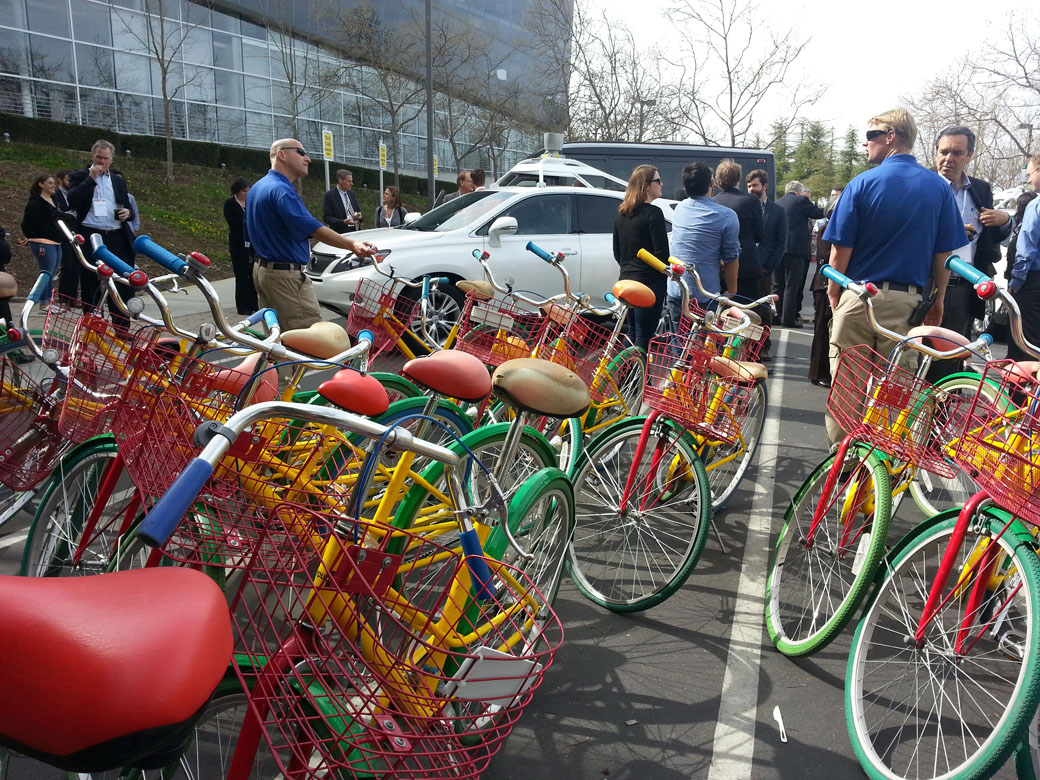
Zero-occupancy vehicles
Photo credit: Benjamin de la Peña.
I was at the Googleplex in Mountain View, Calif., recently for a meeting convened by the New Cities Foundation and Google. About 100 of the top transportation experts from around the world were in the room to discuss the future of urban mobility. There were urbanists and designers, engineers and economists, researchers and city officials, such as Mayor Chris Coleman of St. Paul, Minn.
Google, of course, took the time to show off its autonomous vehicle, aka the “self-driving car.” Its current incarnation is a white Lexus SUV, nondescript except for the spinning LIDAR contraption where the luggage rack should be and a Google logo with a smiley car painted on a rear passenger door. Some of us even got to ride the cars. (Sadly, not me.)
In the parking lot where the tech giant was showing six of these smiley robot cars were dozens and dozens of yellow bikes that belong to Google’s campus-wide bike sharing service. It was fascinating that while the engineers talked up the robot cars, other Googlers were quietly coming and going via the yellow bikes in the background.
The Google engineers also didn’t talk about the big Google buses that were streaming in and out of campus at the start and end of the day. These buses were huge tourist coaches, white but without the Google logo or smiley face and trying to be as nondescript as a 40-foot bus can be. Googlers were patiently waiting to get on these contentious buses that would shuttle them, mostly to San Francisco and Oakland, but also to San Jose and Marin County. Some of the bus waiting areas had tables with power outlets so the Googlers could juice up their laptops.
It was hard not to notice these juxtapositions. Here was one of the most powerful tech companies in the world talking about technology that they were sure would reshape cities. They presented technology, with information and silicon in its heart, meant to relieve us of the duties of the long commute or the search for a parking slot. It’s hard not to be optimistic when your company dramatically reshaped how we get information and how we engage with each other on a global scale. Meanwhile, their colleagues were lugging technology on their backpacks taking shared bikes across campus or sitting in Wi-Fi-enabled buses being productive through a long commute. The buses set to take them to vibrant downtowns that lately have not been so welcoming of the service or their presence.
The optimists say the robot cars will make our roadways safer, our commutes more efficient. They will take 70 percent of the cars off the road and eliminate the need for parking buildings because the cars will be a service that will pick up and drop people off on demand.
Others are not so sure. We know that any new road capacity we build gets taken up by induced demand. Will robot cars encourage more people to take otherwise needless trips? Rather than making cities more efficient, will it induce “super-sprawl” and four-hour commutes because you can sleep through the ride? (Diana Lind reminded me that the advent of the PC was supposed to create the paperless office and reduce paper consumption. We didn’t account for how desktop publishing, WYSIWYG and laser printers made it so much easier to consume pulp.)
Robin Chase offered a frightening vision of herds of “zero-occupancy vehicles” asked by their owners—or renters—to just keep going around the block because “I’ll only take a minute inside” or clogging highways for the long commute home to pick up the kids and take them to their destinations.
While we were there to discuss mobility and transportation, the frame was really “What will our cities look like? What kind of cities will we live in? How is technology shaping our cities?” Also, “Who gets to shape the future of cities? Is it the private sector or government?” (One interesting question, “What happens when the first home-brewed robot car comes along?” To which, the techno-libertarians had to reply, “We’ll need better regulation.”)
The future, of course, will likely provide a complex answer. While it will take the better part of the decade before robot cars go from concept to everyday service, tech-enabled city bike-share services are taking over cities. Municipal bus systems and public transit are seeing increased ridership (the highest since the 1950s) and real-time information (over phone apps) are helping that increase. And while the federal and state governments are cutting down on transportation funding, cities and counties are passing referendums to levy taxes to fund local transit projects.
The future of urban mobility is coming. In fact, it is already here, “just unevenly distributed.” It will be some combination of robot cars and bike sharing and tech-enabled mass transit. As with all technologies, the trick is to have it adapt to our cities. We’ve already made the mistake of making our cities around a singular technology and that has gotten us into quite a mess.
What we need now and moving forward is to focus less on the technology and more on the user. Cities, after all, are about people.
Benjamin de la Peña, director of community and national strategy at Knight Foundation
Recent Content
-
Community Impactarticle ·
-
Community Impactarticle ·
-
Community Impactarticle ·


